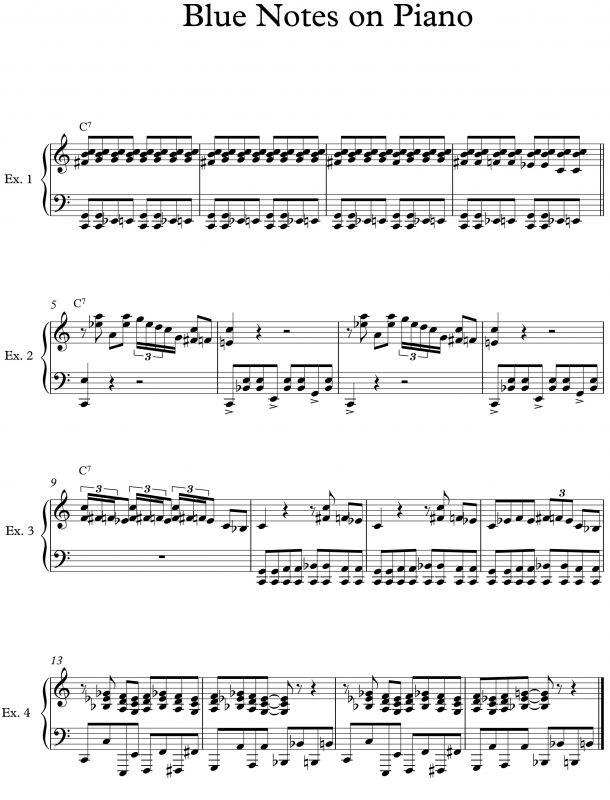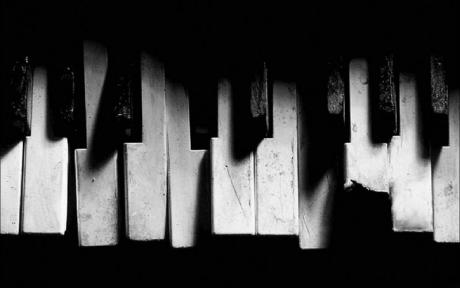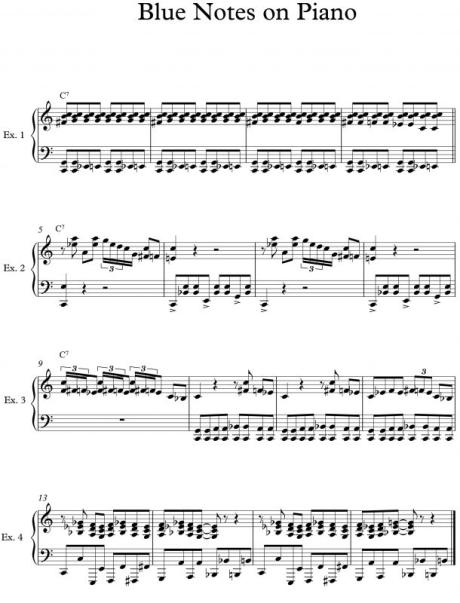Rockové klávesy - Bluesové tóny na pianu

Greetings, readers! Welcome to another installment of Rock Keyboards. This month I’ve written a short blues etude so you can get some authentic blue note riffs into your sound. Each part of the etude is four bars long and covers a slightly different approach of using blue notes. The whole piece is in C, but for true mastery, transpose into 12 keys!
Exercise #1 Boogie Woogie 101
Bars 1-4 has a steady boogie-woogie bass line in the left hand with 5ths and a chromatic approach note to the third of the chord (E). The right hand part comes from the C blues scale (C, Eb, F, F#, G, Bb, C). The first 2 bars use the blue note (F#) as an approach to the G which is played in 1/8th notes with a dissonant cluster of notes from the scale (Bb, C) played at the same time as the bottom note moves up and down the blues scale.

Exercise #2 New Orleans pronounced “Newallins”
Bars 5-8 are influenced by New Orleans pianist, Dr. John. The left hand makes a 10th stab then the right hand harmonizes an A blues scale (A, C, D, Eb, E, G, A) with clusters from the scale and a rolling triplet rhythm. The relative minor Blues scale sounds great in C. It has a sweet, major sound. After the riff, the left hand follows with a accented funky 2nd line rhythm. On the roll down, try to use the 3rd finger for both the Eb and D for a slippery funky sound.
Now we use some different bass parts and start harmonizing our blues scale with some chords.
Exercise #3. Modern turns
Bar 9-12 have another bluesy turn. This one goes quickly to the blue note and down again while keeping the C in the high register. When the left hand enters it does a slightly different Boogie Woogie pattern. This one goes up to the 7th of the chord (Bb) and back down again. Try to play the triplet rhythm a little sloppy to get the authentic sound
Exercise #4. Disco Kid
Bar 13-16 have a funky bass line in the left hand that walks down to the third of the chord (C) then back up the mixolydian mode with 2 chromatic notes (F# and B). The right-hand part harmonizes the C blues scale (C, Eb, F, F#, G, Bb, C) with the addition of the 9 (D)
Blue note: Postup nejčastěji používaný v jazzu (a samozřejmě blues), kdy zazní mollový interval tam, kde by se za normálních okolností očekával durový. V praxi jednoduše zahrajeme tón, který je o půltón níže, než by diktovala použitá stupnice. Příklady blue notes najdete ve všemožných žánrech, zdaleka nejen v jazzu. Poslechněte si například pianové sólo Marka Kellyho z Marillion ve skladbě Man of a Thousand Faces. Jeden moment tam zní téměř jako chyba, ale bez něj by to nebylo ono. Může za to právě blue note.
Chromatic approach note: Approach note je takový tón, který vytváří pnutí a napovídá uchu, k jakému dalšímu tónu spěje. Následující tón pak má většinou povahu „resolution“, tedy uvolnění napětí. Když pak přidáme adjektivum „chromatický“, získáme pojem „citlivý tón“, který může být buď vzestupný nebo sestupný. Ten se od cílové noty liší právě o půltón a spěje k ní buď shora nebo zespodu.
Cluster: Shluk tónů, tedy akord skládající se z alespoň tří sousedních tónů stupnice. Jednou z nejpoužívanějších variant je tzv. chromatický cluster, v němž je interval mezi sousedními tóny vždy půltón. Takový shluk lze použít velmi efektně, protože působí opravdu disonantně a posluchače správně „zatahá za uši“.
Sloppy playing: Když v anglickém textu zahlédnete tuto frázi, je vždy třeba znát kontext. Obecně totiž může působit pejorativně a znamenat hru, které chybí preciznost. Pravda však je, že takový styl hry na nástroj někdy používáme záměrně a hrajeme tzv. kolem rytmu, tedy všechny či některé tóny zahrajeme dříve nebo později. To někdy může působit expresivněji než otrocky dodržovat rytmus, a právě tak to i Brian myslel v tomto díle seriálu.




